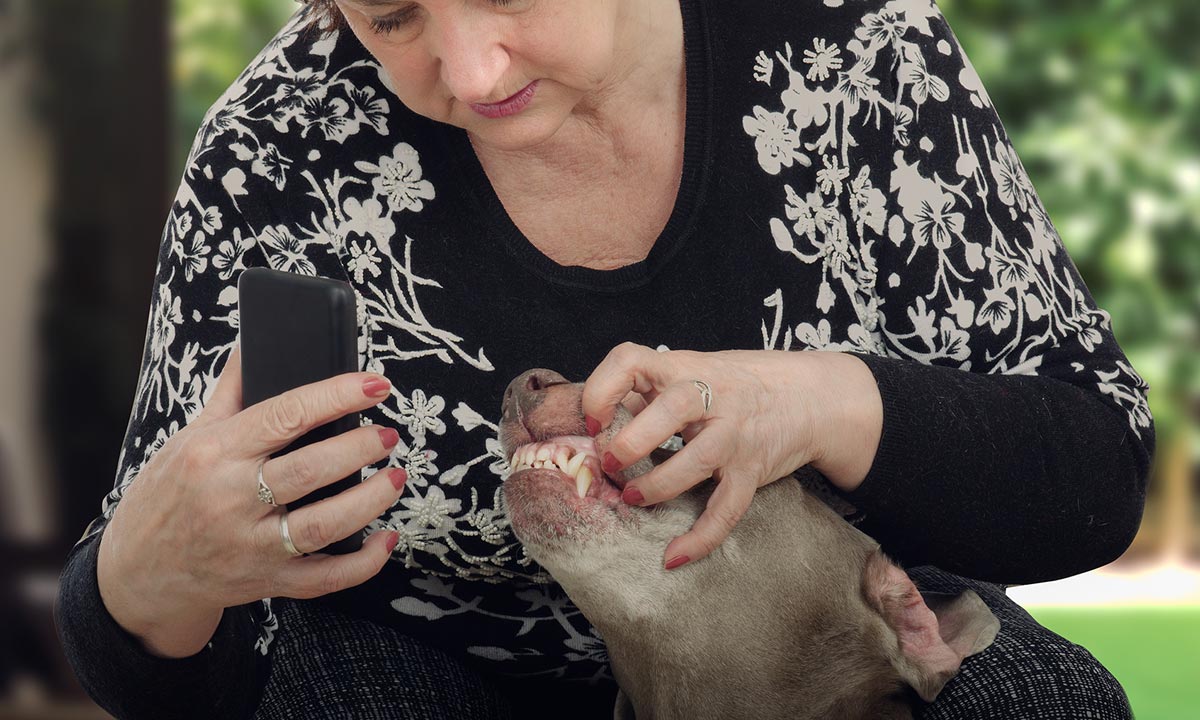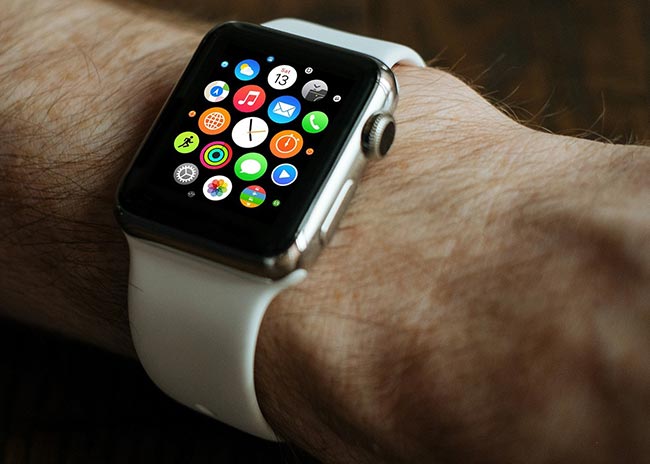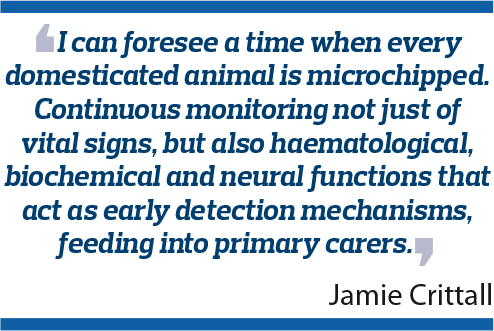1 Sept 2017
Technology in all its forms has already proved to be a huge disruptor for veterinary practices across the UK. Staying up to date with the latest developments can be a challenge, but upsides exist for those willing to embrace these advances. We asked our panel to share their vision of this brave new world.

Of all the topics we put to our Big 6 panel, the subject of technology was, arguably, the most challenging.
By asking a disparate group of vets, vet nurses and business owners how they thought technology would shape their working landscape, we were effectively asking them to take a leap of faith; not something evidence-based veterinary professionals are always comfortable doing.
In this case, however, that faith was rewarded as our 16-strong panel rose to the challenge brilliantly, with more than 50 separate posts on this subject adding up to almost 10,000 words of comment and thought-provoking insight.
The following article is not a tech instruction manual, nor was it ever intended to be. Instead, it is a broad sweep of the tech forces our panel felt would likely have the biggest impact on veterinary professionals over the next decade.
 In 10 years’ time we may discover our panelists were spot on, or they may have been well wide of the mark. Either way, their thoughts and opinions make for a fascinating second article in the Big 6 series…
In 10 years’ time we may discover our panelists were spot on, or they may have been well wide of the mark. Either way, their thoughts and opinions make for a fascinating second article in the Big 6 series…
 Without the benefit of a crystal ball or time machine, predicting the future can be a thankless task.
Without the benefit of a crystal ball or time machine, predicting the future can be a thankless task.
To do so for vets is doubly difficult. A multitude of different business models proliferate to muddy the waters, while there can be few other professions or sectors so exposed to the ever-changing whims of the public.
Computerised systems have revolutionised how practices manage their day-to-day functions and few can have predicted the imaging revolution that put modalities such as digital x-ray, MRI and CT at the fingertips of first opinion vets.
Widespread technological disruption has also occurred due to the rise of the internet, and with it the all-pervasive world of social media, while online webinars have changed the way many vets now meet their CPD obligations.
And that’s just for starters, with virtual consults, telemedicine and “Dr Google” all set to change the way vets go about their jobs. Practices ignoring these tech trends do so at their peril.
So tasking our panel to predict how technology is likely to transform the working lives of vets over the next decade was asking a lot. But they gave it their best – and it was the future impact of social media that proved the main talking point.

Getting the ball rolling, practising vet and co-founder of Virtual Recall Jamie Crittall emphasised the power social media has to influence clients when they are not even in the practice.
“We as a profession should do everything we can to avail ourselves of all the fantastic digital communication channels that exist to influence our clients beyond the consult room,” he said.
“But there must be an absolute emphasis on simplifying the clients’ user experience – bearing this in mind, the technology closest to the ever-growing number of millennials’ hearts is mobile.”
According to statistics released by Google, mobile searches outstripped desktop searches for the first time in 2016. With this trend showing no sign of slowing, Onswitch managing director Alison Lambert said: “I agree with Jamie – we need to see how we can make the customer experience easier and smoother. For most folks, that means mobile platforms.
“The fact is, technology will continue to deliver new options to the owner. They are already using consult platforms on mobile, while telematics is real for human medicine – so why not vet?
“Also, mobile data capture is real and here today, so embracing it is the key; we will not stop it – in the same way vets used to say websites won’t catch on or Facebook is a silly phase… mobile vet tech will be normal.”
While some practices have still not wholeheartedly embraced the mobile-driven social media revolution, others saw the writing on the wall some time ago. First opinion vet and practice owner Lorna Clark believes these advances are set to revolutionise the way practices interact with clients – but they need to stick with it.
“Social media is a fantastic and free marketing tool,” she said.
“We are so lucky in the profession to have such great Facebook fodder, so should use it. My friend owns a greengrocery, but I suspect daily Facebook posts about fruit and veg are slightly more difficult for her to sustain than they are for us.
“Interestingly, we launched an app recently, but it hasn’t had quite the impact we expected it to as most people still prefer to telephone us than use the app to book appointments and reorder meds.
“But we have to persevere, because it’s the next bunch of adults who will be completely mobile savvy.”
Embracing technology can help engage customers, Lorna said – from email, text reminders and pushes on apps, to Facebook posts and tweets. “My fantasy is an iPad in reception so customers can use our virtual shop on it,” she said.
“Imagine – a retail outlet without the space, stock and manpower outlay; a forum to give feedback, update their own details and so on, as they wait.”

Another area of technological advance likely to cause some disruption is the rise of telemedicine.
In an RCVS consultation on the subject earlier this year, the college said telemedicine can be defined as “any clinical health care service provided using remote telecommunications services”.
This included video call services such as Skype, wearable technology for pets similar to a Fitbit, and other online consultation services.
Outlining some of the concerns around the rise of this type of tech, the college said: “Our code of conduct and supporting guidance is generally concerned with face-to-face provision of veterinary services.
“The consultation will consider issues such as who is responsible for veterinary care if it is provided remotely; how ‘under veterinary care’ is defined in the context of the telemedicine delivery of services; the potential risks, as well as opportunities, for improving animal welfare that may arise out of new technologies; and the appropriate regulation of veterinary services provided directly to clients using new remote technologies.”
Telemedicine may still be in its infancy in the veterinary sector, but as senior partner at Medivet Adi Nell warned, it will soon be a reality.
“Change is inevitable and the profession will have to embrace it,” he said.
“There are limits to this, though. A hands-on examination will almost always be needed to make a diagnosis. Humans can describe their signs and symptoms, and input these into an algorithm with pretty good results. That’s far harder for a pet owner.
“It’ll be interesting to see what some of the new pet wearable technologies can deliver in terms of preventive care and diagnostics. This is all just starting to take off and there is a lot of interest in their health benefits and, of course, commercial promise.”
With video call services such as Skype, a practice is already putting this to good use, said RVN Helen Tottey.
On Alderney in the Channel Islands, the only veterinary practice is primarily run by a nursing team, led by the much-respected and lauded RVN Kathy Kissick.
“The nurses run the health care on the island with a vet going over every two weeks,” said Helen.
“When they need vet input, they use technology such as Skype to show the vet on the mainland the pet, talk through the results of the temperature, pulse and respiration tests they have done and any other things. The vet diagnoses and asks the nurse to give the treatments.”
With a large number of UK pets never seeing a vet, Helen wondered if there was an application for the process here.
“Could we be following the approved-by-RCVS Alderney model for pet owners on UK mainland?” she said.
“What about out-of-hours, where a lot of pets coming in would be okay until the morning if the owners could just show the wound to someone, who, in turn, would reassure it could be looked at tomorrow?”
 On wearable tech, Big 6 forum moderator and veterinary consultant Ross Tiffin said features of it that report directly back to the practice “will remove the imperative for the pet owner to trigger a specific action”.
On wearable tech, Big 6 forum moderator and veterinary consultant Ross Tiffin said features of it that report directly back to the practice “will remove the imperative for the pet owner to trigger a specific action”.
“Therefore, what’s fascinating here is the option to completely change the business model for pet owners using wearable tech, owned by the practice, on their pets,” he said.
“That way, the practice gets to control much of the clinical and business environment, rather than the pet owner while, all the time, doing so with the blessing and financial support of the pet owner. This could possibly be the only way to change the business model in such a competitive environment.”
This maintaining control over the issuing and monitoring of wearable tech for the purposes of telemedicine was highlighted by Elly Pittaway, a practising vet and practice owner from Coventry.
“The RCVS survey was interesting and makes you wonder how legislation will ever catch up with it all, as this area seems to be moving so fast,” she said.
“There is a real concern owners will put what the ‘computer’ tells them above what we tell them, so it will be vital for vets to explain [to owners] the limitations of some of the devices they are using.
“Also, as Ross says, ideally these devices would be somehow tied into the owner’s practice in future, so a vet is overseeing them and alerted if there is a real issue.
“Distant consulting via video link concerns me, and I agree with Adi that you just can’t replace a clinical exam to pick up on that subtle change in gum colour, to auscultate, palpate, do a full ophthalmic or otic exam, or just to follow your instinct further that something isn’t quite right in the pet’s demeanour, gait or manner.”
Qualified vet and veterinary business consultant Dave Nicol said he was “both delighted and concerned” about pet wearables and other tech advances.
“The potential for early disease flagging is clearly a massive benefit,” he said.
“The augmentation of the existing flawed examination process, providing objective data without veterinary bias or beliefs getting in the way, is also massive.
“Artificial intelligence already seems to be running rings round human specialists in terms of accurate and consistent diagnosis, all of which starts you getting a tad concerned about exactly why we’ll even need vets, doctors or dentists in future – expensive to train, steep learning curve, ego galore, prone to bias… one could get a little concerned about becoming redundant. Aside from one fact – they made the Terminator and we’ll never trust Skynet!
“On the communications side,” he continued, “we have such a brilliant opportunity to reach pet owners. As noted by others, the content we have available is awesome and engaging, so we really have to up our game in terms of content creation, distribution and conversion from reader into client.
“Then there’s the use of cloud-based services to improve management practices and learning… all of which make me very optimistic – until the robots come to crush human civilisation, that is – we are in the best period for veterinary business ever.”

Contemplating a world where new communication platforms, artificial intelligence and increasingly smart pet tech could fundamentally change the role of the vet would give anyone pause for thought.
Threats always exist, but, according to Jamie Crittall in this brilliant post, some amazing opportunities also exist for those willing to take them.
“We already have amazing tech – CT, MRI and implantable electrodes to replace severed nerves,” he said.
“Robots carry out surgery in operating theatres while the ‘surgeon’ directs from an office thousands of miles away. Common molluscs have been discovered to detect early warning biochemicals in blood before fatigue or illness has occurred, enabling simple interventions to prevent the breakdown or illness.
“These are brilliant things; clever things, but they are not fully integrated – yet – and rely on people and many manual processes, for now.
“Let me set the scene,” he continued. “Our Virtual Recall office is in the Surrey Research Park, just around the corner from the 5G Centre. I was lucky enough to hear one of the founding directors speak about their developments last year. He described the speeds of their current beta-5G as already being 2,000 times faster than the fastest 4G Wi-Fi signals, and that they are aiming to go live by 2020, when they expect speeds to be so much faster still.
“The centre also collaborates with other tech companies building devices that will enrich our lives among the Internet of Things. These devices will all talk to each other seamlessly across enterprise solutions to help us become better connected and more aware of all things around us, including ourselves.
“These will be our fridges, devices, wearables, shops, houses, offices and ‘planes, trains and automobiles’ – technology monitoring our every move, mood and process to give us a better, more connected and integrated experience.”
 Jamie went on to explain how “big data” (see Panel 1), algorithms and artificial intelligence will enhance both the lives of humans and, in the case of the veterinary sector, the animals under their care.
Jamie went on to explain how “big data” (see Panel 1), algorithms and artificial intelligence will enhance both the lives of humans and, in the case of the veterinary sector, the animals under their care.
“I can foresee a time when every domesticated animal is microchipped,” he said.
“Continuous monitoring not just of vital signs, but also haematological, biochemical and neural functions that act as early detection mechanisms, feeding into primary carers, who will, in turn, ensure proactive remedies or diagnostics are implemented.”
These “primary carers” will still have an integral role, said Jamie, despite the tech’s obvious abilities.
“We will still need the human interaction more than ever to ensure the client/patient experience lives up to the ever-growing expectation of excellence is met,” he said.
“It’s an absolute key time for nurses and perhaps the current vet to manage health from a more technical role with greater oversight.
“More appropriately trained medics and vets will ensure artificial intelligence is running smoothly, helping to make the best decisions to obtain the best outcomes.
“Is this science fiction? In my opinion, it is beginning to blur very quickly into science fact.”
Such a blur means the vets of the future could hold the “keys to health” at the tip of their fingers, said Jamie, which could have wider consequences across the profession.
“Would these possibilities provide the solution for the work-life balance challenge?” he said.
“Would gender well and truly be immaterial? Would the corporate versus independent model be of little consequence – that is, would they help to grow the market, having potentially shrunk the size of the profession? But wow – in my opinion – the career opportunities may be endless.
“All things considered, we may all have more time on our hands,” he added.
“We could volunteer and spend our well-earned time and money on ensuring the world stays fit for all living creatures and plants, such that a career in the veterinary sector may bring us even greater happiness and ‘riches’.
“Just a thought…”
In today’s technological world, relational databases are beginning to be seen as old hat, little more than a useful way of managing and manipulating (relatively) small amounts of similar data.
The buzzword now is “big data” and, like a lot of buzzwords, the term means different things to different people.
All practices will have, over the years, built up stores of data in various formats, but, due to technical limitations, been unable to harness the true value of that information.
Here at Veterinary Business Development (VBD) – publisher of VBJ – this scenario has taken on particular significance for our tech bods in recent years.
With several large, unconnected databases and various disparate data streams flowing into the business, it became the job of digital manager Sean Mitchell and his team to harness its power.
He said: “The way we see big data at VBD is as a combination of all our other data sources. We have a website (vettimes.co.uk), we have the job site (vet times jobs), we have CPD, we have Vetfile, which is our readership database, and we also have Goldmine, which is our sales database and we also have data from social media and email marketing.
“So, the idea of big data to us is getting all those data sources into one repository – one huge database that pulls in information from all those sources – that is part one of our job and it is a massive task.
“So why are we going to all that effort?
“Part two of the job is to make sure all that resource is put to good use. We are building a ‘data warehouse’, so we can pool all that data and use it in a more intelligent, targeted way.
“This will enable us to provide better content for our users as we will be able to better tailor the content seen by our many thousands of readers. We will be able to build a bespoke experience for those people and give them more of what we know they want, and less of what we know they don’t.
“It is a bit of a paradox really, as we are using big data to focus down on potentially very small, targeted areas to improve our users’ experiences of our content.”
Big data already impacts on every facet of each and every one of us in our personal and business lives and, just as Facebook and Twitter have embraced the rise of smartphones with GPS and internet connectivity, and revolutionised the way we communicate socially, then the same principles will surely revolutionise the lives of our clients, and, therefore, change the way they relate to us.
So, whatever the disagreements over the definition, most people in business agree on one thing: big data is going to be a big deal, and will lead to huge new opportunities and growth in the coming years for those who successfully embrace the concept.
SPVS junior vice-president and veterinary scientific liaison at Bayer Catriona Curtis highlighted one of the practical ways technology is already being harnessed to improve animal welfare.
She said: “The future is tech and in the medical field, advances are evolving at an exponential rate.
“I was chatting to an old university friend the other day, who now regularly uses the in-situ continuous glucose monitoring sensors. They said they’ve vastly improved the practice’s diabetic management – dogs and cats are less stressed, unstable diabetics are picked up quicker and, generally speaking, fewer practice visits are required, which makes both the owner and pet happier.
“There’s a lot of talk in the tech world and in books as to how nano-robots will be used in medical fields for diagnostic purposes, treatment and so on.
“Ventures such as remote consulting are here to stay,” she continued.
“A number of my friends, who are great small animal vets and highly experienced, work on a consultancy basis doing this while on maternity leave, and as another income stream when working part-time.
“They say a high percentage of the time they finish the call saying ‘we’d advise you to visit your vet practice’.
“So, perhaps [this] could drive footfall to our practices?”
![]()
The Big 6 panel thought:
Rounding things off, discussion turned to the use of net promoter score (NPS) – a measure of customer satisfaction and loyalty, expressed as a single number. Sure, it’s a tech already used, but are we finding out what we need from it? Or do we rely on it too much?
Virtual Recall helps its customer practices with theirs. Jamie Crittall said: “We have loads of customer practices asking their clients about the level of their service.
“We automate it to ensure every client is asked and the average NPS is amazing – more than 70 – for them. Clients really like their vets – we’re not perfect, but we are trying.”
XL Vets director Andrew Curwen, however, wondered if NPS goes far enough. “The power of recommendation is critical and its value immense,” he said. “However, I find that while it is really important the practice team understands the concept and principles of NPS, the value of the actual tool in vet practice can be reduced relative to other industry sectors.
“Our pharmaceutical suppliers might range between -100% to +75% [for example], but you will find most vet practices will fall into a much tighter score and tend towards higher figures.
“If you consider it from a psychological perspective, that should be no surprise – I am unlikely to give a low ‘recommend to a friend or family member’ score for a vet I have already recommended to my ‘best friend’.
“Of course, it’s the ‘why’ behind the score that is always the most illuminating, and a constant reminder that, whether we are companion animal or farm practice, we are a service industry.”
Summing things up, Jamie said he hopes tech, in whatever its form, can direct owners to the best evidence-based health care that will, in turn, lead to the best outcomes.
“I think, and hope, this is where a good veterinary practice can prosper, in collaboration with their clients – both newly acquired and existing, loyal ones – to grow the market, provide better careers, improved work-life balance and bonded person to person relationships,” he said.